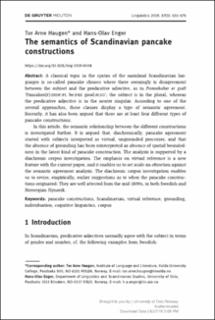The semantics of Scandinavian pancake constructions
Peer reviewed, Journal article
Published version
Permanent lenke
https://hdl.handle.net/11250/3072651Utgivelsesdato
2019Metadata
Vis full innførselSamlinger
Sammendrag
A classical topic in the syntax of the mainland Scandinavian languages is so-called pancake clauses where there seemingly is disagreement between the subject and the predicative adjective, as in Pannekaker er godt ‘Pancakes(f):indf:pl be:prs good:n:sg’; the subject is in the plural, whereas the predicative adjective is in the neuter singular. According to one of the several approaches, these clauses display a type of semantic agreement. Recently, it has also been argued that there are at least four different types of pancake constructions.
In this article, the semantic relationship between the different constructions is investigated further. It is argued that, diachronically, pancake agreement started with subjects interpreted as virtual, ungrounded processes, and that the absence of grounding has been reinterpreted as absence of spatial boundedness in the latest kind of pancake construction. The analysis is supported by a diachronic corpus investigation. The emphasis on virtual reference is a new feature with the current paper, and it enables us to set aside an objection against the semantic agreement analysis. The diachronic corpus investigation enables us to revise, empirically, earlier suggestions as to when the pancake constructions originated: They are well attested from the mid-1800s, in both Swedish and Norwegian Nynorsk.
